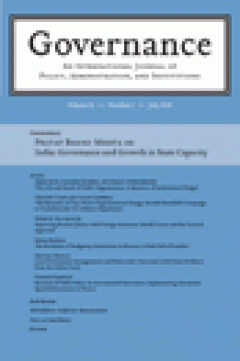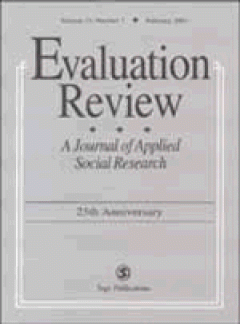Filter by

Traditional Leaders and the Culture of Governance in South Africa
The global neoliberal economic and political order impregnated the emergence of democracy in South Africa. One of the hallmarks of this order is that the capacity of the state to transform society is constrained, particularly in the rural hinterlands. The incapacity of the state to extend its grip, both economically and politically, has provided traditional leaders with an opportunity to both r…
- Edition
- Volume 24, Issue 1, January 2011. pages 5–29
- ISBN/ISSN
- 09521895
- Collation
- -
- Series Title
- Governance
- Call Number
- -

Power Sharing and Inclusive Politics in Africa's Uncertain Democracies
Power-sharing agreements have been widely used in Africa as paths out of civil war. However, the research focus on conflict mitigation provides an inadequate guide to recent cases such as Kenya and Zimbabwe. When used in response to flawed elections, pacts guaranteeing political inclusion adversely affect government performance and democratization. Political inclusion in these cases undermines …
- Edition
- Volume 24, Issue 1, January 2011. pages 31–53
- ISBN/ISSN
- 09521895
- Collation
- -
- Series Title
- Governance
- Call Number
- -

Transgovernmentalism Meets Security: Police Liaison Officers, Terrorism, and …
Studies of transgovernmental activities have enhanced our understanding of changing global politics, but their claims have not been fully investigated with respect to the security realm. Therefore, this article first acknowledges a gap between the practices and capacities of nonstate entities creating transnational threats and those of state-based agents of response. States' ability to respond …
- Edition
- Volume 24, Issue 1, January 2011. pages 55–84
- ISBN/ISSN
- 09521895
- Collation
- -
- Series Title
- Governance
- Call Number
- -

A Contagious Concept: Explaining the Spread of Privatization in the Telecommu…
Qualitative studies suggest that the spread of privatization of public utilities is due to a change of the economic paradigm and institutional isomorphism pressures. However, current quantitative studies mostly account for domestic factors. These factors can explain differences in national privatization trajectories but cannot explain the large trend. Based on a quantitative analysis of privati…
- Edition
- Volume 24, Issue 1, January 2011. pages 111–139
- ISBN/ISSN
- 09521895
- Collation
- -
- Series Title
- Governance
- Call Number
- -

Toward a New Era of Administrative Reform? The Myth of Post-NPM in New Zealand
This article explores the supposed shift from New Public Management (NPM) to a new era of �post-NPM� by looking at one critical case, New Zealand. It finds limited evidence of such a shift, suggesting that the wider literature needs to move to a more careful methodological treatment of empirical patterns. To contribute to such a move, this article applies a three-pronged approach to the study o…
- Edition
- Volume 24, Issue 1, January 2011, pages 141–166
- ISBN/ISSN
- 09521895
- Collation
- -
- Series Title
- Governance
- Call Number
- -

The New York School of Philanthropy, the Bureau of Municipal Research, and th…
This article uses archival research to analyze the role of the New York School of Philanthropy as a precursor to the Bureau of Municipal Research (BMR) Training School, which is generally considered the first professional public administration program in America. The article argues that the two organizations had similar curricula and aspirations in the early Progressive period, particularly fro…
- Edition
- Vol. 43 no. 1, January 2011.pp. 3-21
- ISBN/ISSN
- 00953997
- Collation
- -
- Series Title
- Administration & Society
- Call Number
- -

Public Organizations and Mission Valence : When Does Mission Matter?
Given the service- and community-oriented nature of organizational goals in the public sector, it is not surprising that public management scholars have highlighted the potential of the missions to be an asset of public organizations. To date, however, little empirical research has investigated ways in which these benefits can be cultivated. The present study of mission valence�based on a sampl…
- Edition
- Vol. 43 no. 1, January 2011.pp. 22-44
- ISBN/ISSN
- 00953997
- Collation
- -
- Series Title
- Administration & Society
- Call Number
- -

On the Nature and Strategies of Organized Interests in Health Care Policy Making
Relying on a sweeping review of the literature on interest group influence in health care policy making, we propose a basic definition and a typology of interest groups in provincial health care policy making. Then, using Milbrath�s communication framework, we analyze organized interests� strategies for influencing policy making. This article is a modest attempt to cross-fertilize the group the…
- Edition
- Vol. 43 no. 1, January 2011.pp. 45-65
- ISBN/ISSN
- 00953997
- Collation
- -
- Series Title
- Administration & Society
- Call Number
- -

Continuing an Alternative View of Public Administration : Mary van Kleeck and…
This article argues that from 1918 through 1927 prominent social scientist and reformer Mary van Kleeck (1883-1972) pursued an alternative theory of public administration enunciated by women reformers in the early 1900s. van Kleeck continued to support the theory through her idea of industrial citizenship, through which labor and capital would work as equals. Two new forums for her idea�the Int…
- Edition
- Vol. 43 no. 1, January 2011.pp. 66-86
- ISBN/ISSN
- 00953997
- Collation
- -
- Series Title
- Administration & Society
- Call Number
- -

Strategic Planning As an Effective Tool of Strategic Management in Public Sec…
This study determines the effectiveness of strategic planning as an effective tool of strategic management in public transit agencies. It finds that an effective strategic planning requires top managers� active roles in defining the strategic direction of the organization and creating an environment that recognizes strategic planning as a tool of strategic management. Also, it requires good wor…
- Edition
- Vol. 43 no. 1, January 2011.pp. 87-123
- ISBN/ISSN
- 00953997
- Collation
- -
- Series Title
- Administration & Society
- Call Number
- -

Out of the Woods : Facilitating Pragmatic Inquiry and Dialogue
In �Into the Woods,� Karen Evans describes an increasingly hollow public administration environment that is shaped by a misplaced quest for efficiency. She looks to the pragmatism of John Dewey as a way to remedy the situation. This article extends her analysis by linking pragmatism to reflective thought, inquiry, nonlinear dynamics, and communication theories. Finally, a few suggestions for ho…
- Edition
- Vol. 43 no. 1, January 2011.pp. 124-132
- ISBN/ISSN
- 00953997
- Collation
- -
- Series Title
- Administration & Society
- Call Number
- -

On the Problem of Adopting Pragmatism in Public Administration
Answering the question, �Should public administration adopt pragmatism?� requires some agreement on what pragmatism means and what that adoption might entail. This article argues that such agreement does not currently exist and, without it, calls by administrative theorists for adoption will not receive their intended responses.
- Edition
- Vol. 43 no. 1, January 2011.pp. 133-141
- ISBN/ISSN
- 00953997
- Collation
- -
- Series Title
- Administration & Society
- Call Number
- -

KANT'S CONCEPT OF INTERNATIONAL LAW
Modern theorists often use Immanuel Kant's work to defend the normative primacy of human rights and the necessity of institutionally autonomous forms of global governance. However, properly understood, his law of nations describes a loose and noncoercive confederation of republican states. In this way, Kant steers a course between earlier natural lawyers such as Grotius, who defended just-war t…
- Edition
- Volume 16, Number 4, December 2010.pp.229-257
- ISBN/ISSN
- 13523252
- Collation
- -
- Series Title
- Legal Theory
- Call Number
- -

How We See Them Versus How They See Themselves: A Cognitive Perspective of Fi…
The present study complements current firm�nongovernment organization (NGO) literature by emphasizing the influence of managerial cognition on organizational behavior. In particular, I find that NGOs confront or seek to collaborate with other NGOs or with firms to appear as legitimate actors before selected third parties and as a way to access various sources of funds. By contrast, firm manager…
- Edition
- Vol. 49 no. 1, March 2010.pp. 116-139
- ISBN/ISSN
- 00076503
- Collation
- -
- Series Title
- Business Society
- Call Number
- -

Improving Ascertainment of Risk Factors for HIV Infection: Results of a Group…
To allow appropriate allocation of prevention and care funding, HIV/AIDS surveillance data must include risk factor information, currently available for less than 70% of cases reported in the United States. The authors evaluated an intervention consisting of provider training and materials to improve risk factor reporting. Facilities were matched prior to randomization to intervention or contro…
- Edition
- Vol. 34 no. 6, December 2010.pp. 439-454
- ISBN/ISSN
- 0193841X
- Collation
- -
- Series Title
- Evaluation Review
- Call Number
- -

Examination of the Empirical Research Environment of Program Evaluation : Met…
The study dealt with a research environment in which the treatment effect is heterogeneous, and in which individuals use their assessments of the treatment effect to decide whether or not to enroll in an intervention program. In this article, a new methodology is proposed for examining the validity of the specified research environment in a given intervention program and database. The methodolo…
- Edition
- Vol. 34 no. 6, December 2010.pp. 455-486
- ISBN/ISSN
- 0193841X
- Collation
- -
- Series Title
- Evaluation Review
- Call Number
- -

A National Evaluation of Community-Based Youth Cessation Programs : Design an…
Although widely available, little is known about the effectiveness of youth cessation treatments delivered in real-world settings. The authors recruited a nonprobability sample of 41 community-based group-format programs that treated at least 15 youth per year and included evidence-based treatment components. Data collection included longitudinal surveys of youth participants (n = 878); posttre…
- Edition
- Vol. 34 no. 6, December 2010.pp. 513-548
- ISBN/ISSN
- 0193841X
- Collation
- -
- Series Title
- Evaluation Review
- Call Number
- -

Evaluating a Policing Strategy Intended to Disrupt an Illicit Street-Level Dr…
The authors examined a strategic policing initiative that was implemented in a high crime Nashville, Tennessee neighborhood by utilizing a mixed-methodological evaluation approach in order to provide (a) a descriptive process assessment of program fidelity; (b) an interrupted time-series analysis relying upon generalized linear models; (c) in-depth resident interviews. Results revealed that the…
- Edition
- Vol. 34 no. 6, December 2010.pp. 513-548
- ISBN/ISSN
- 0193841X
- Collation
- -
- Series Title
- Evaluation Review
- Call Number
- -

CONTRASTIVE CAUSATION IN THE LAW
What conception of causation is at work in the law? I argue that the law implicitly relies on a contrastive conception. In a liability case where the defendant's breach of duty must be shown to have caused the plaintiff's damages, it is not enough to consider what would have happened if the cause had not occurred�the law instructs us to look to a specific replacement for the cause, which in thi…
- Edition
- Volume 16, Number 4, December 2010.pp. 259-297
- ISBN/ISSN
- 13523252
- Collation
- -
- Series Title
- Legal Theory
- Call Number
- -

If Robert Merton said it, it must be true: A citation analysis in the field o…
This article is inspired by the current attention paid to bibliometric methods in evaluating research relevance and impact. The logic behind the trend is examined by comparing highly and less cited publications in the same knowledge field (i.e. performance measurement) to see if and how they are different, especially in terms of research design and methods used. Findings indicate that various r…
- Edition
- Vol. 17 no. 1, January 2011.pp. 7-19
- ISBN/ISSN
- 13563890
- Collation
- -
- Series Title
- Evaluation
- Call Number
- -
 Computer Science, Information & General Works
Computer Science, Information & General Works  Philosophy & Psychology
Philosophy & Psychology  Religion
Religion  Social Sciences
Social Sciences  Language
Language  Pure Science
Pure Science  Applied Sciences
Applied Sciences  Art & Recreation
Art & Recreation  Literature
Literature  History & Geography
History & Geography